How to mess with typography: a selection of working methods
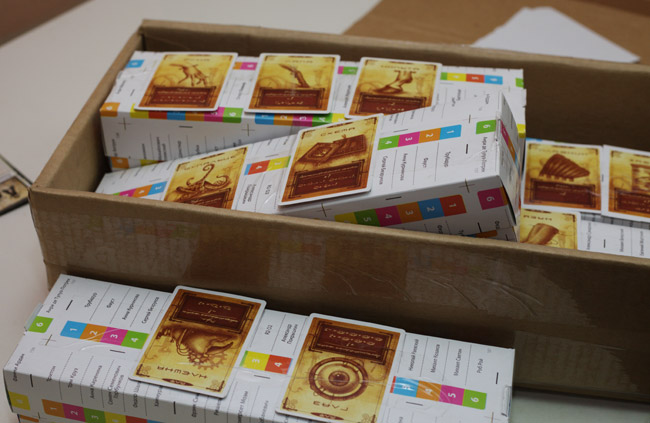
There are probably shoals, we just have not opened the box
For three years, my colleagues and I have been beaten on the head hundreds of times with a rake handle when working with printing houses. We wrote off entire containers of crookedly printed packaging for games, reworked circulation in an emergency way, sent back the marriage that we were trying to pass off as a normal print, and ran into a banal scam.
At first, it may seem that printing houses are special traps for those who cannot correctly formulate a task, read a contract and check a circulation. Later, after a few broken deadlines and broken circulations, an understanding of some basics comes.
')
During this time, we have an algorithm that more or less insures against problems.
1. First you need to find a printing house (or better, a couple) that will print normally.
There are many offices in the market, working without their equipment or with a certain minimum set. As a rule, these are 1-2 digital machines, a guillotine and an unrelated design department. The same offset and widescreen is outsourced.
Hence a simple conclusion - for different types of orders most often different counterparties are needed. For example, the offset should be printed in one place, T-shirts - in another. It comes to unobvious situations when discount cards in another region turn out to be more profitable by 30% in Moscow, even taking into account the delivery. Posters are sometimes more convenient to print in advertising and production agencies, where there are large-format plotters.
The first way to choose a printing house is to find a directory of enterprises (in the regions), open a DoubleGis or google on request a digital print. It has its own peculiarity: sometimes there are different legal entities-satellites of the same center with one set of equipment in reference books and search results. The second option is to write on the print forum (this is a type of freelance exchange for printing houses) and wait for the offers.
When you get a list of about 15 possible performers, you will need to call everywhere and ask you to calculate a certain reference order to compare the options.
For example: “Hello! Calculate, please, how much it will cost to print 500 full-color leaflets in A6 format, one-sided, on a glossy text with a density of 115 grams per meter. ” The answer should be a number, which will then be used for comparison. At the time of publication of the topic, the standard is in the range of 900-1300 rubles, depending on the region. If more - continue searching further. If it is less, you need to think hard, because either they print crookedly (and at a low price they print crooked almost always), or the printing house plays dumping.
At this stage it is necessary to cut off those who are not very adequate. In general, the main thing for us in working with a printing house is to put people, not on prices and hardware. Competent experts always do everything perfectly. At 50% success depends on a smart manager, another 50% - on the printer. Customer-oriented printing houses stand out in the phoned step. Usually, saving a few percent of the cost does not pay off due to unpredictably increasing risks.
The next step is to check the location: in which case the printing house will have to go (especially if urgent orders are planned). As a result, there are about 3-5 options that need to be considered further.
2. We do color proof
This is an important part of the selection. We take the layout, put it into the letter and send it to the printing house: “Hello! We agreed to print flyers by phone, I would like to do a color proof before launching the print run. Attached I send the layout.
If we have a sample (for example, a reference leaflet from Moscow in a regional store) - compare the colors with it. If there is no sample, just look at the quality of color proof. In the case of promotional materials, it is important to more or less fall into color (the difference by a couple of percent is usually uncritical), but in the case of, for example, game components, even a tenth percent shift is noticeable, so it is very important to look next to the samples.
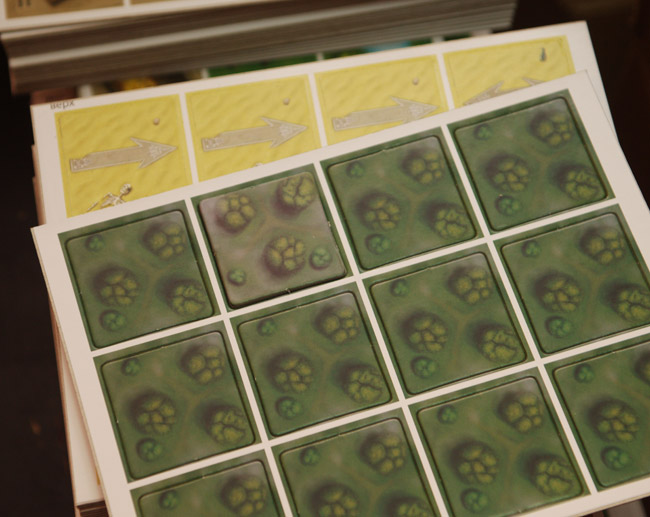
This is how the marriage is seen in the game: this edition went into trouble
At the color proof, it is necessary to evaluate the uniformity of the sheet fill: it happens that the printing device makes a gradient, spots, lines or other filth.
Trial material must be wrinkled, applied to all objects around him, rubbed. For example, once a leaflet was brought to us from a color proof, with which (because of a special paper) the paint stupidly peeled off. As it turned out, the contractor knew everything perfectly, but he believed that everything could be done through marriage, once the customer had signed without knowing the paper’s features.
On the other hand, there is an excellent example of a printing house, with which our production workers have been working for two years already: from circulation to circulation, the same color is provided without question.
3. We conclude an agreement
There are a number of magical features:
- Not all printing houses are ready to conclude a contract when working up to 2000 rubles. Even a lot of one-off work in this range is often not an argument.
- Often proposed framework documents that no one does not commit to anything. Even worse - when the contract is made explicitly in favor of the printing house, and you are obviously wrong even in the case of marriage.
- It is clear that it is useless to prescribe everything at once in the details in the contract: it will turn out to be a 20-page document, which will simply be impossible to read, and even more difficult to sign. Therefore, it is very important to make sure that the person communicating with you is adequate, and will accept the marriage back, even if this marriage was not described in the contract. For example, scratches from the dust on the shirt card - this is a normal tolerance by the standard, but the natural specks for the deck. If the circulation in this case is redone at the expense of the printing house - you are lucky with the performers. Take care of them.
Still it is necessary to understand that printing houses work according to GOST, when a lot is not fixed in the contract. If you are promised, for example, cutting down with an accuracy of 2 millimeters, but in practice you will get 3-4 (which often happens), you will get a marriage, but legally the printing house will be right - this is within the tolerances of the standard.
With a probability of 90%, even with an excellent manager, you will lose the term . This means that the term should be prescribed in the contract, plus include sanctions there in case of going beyond the schedule. Another pitfall is setting a time limit, for example, printing completion, but not delivery: this can be plus a week. In general, the whole delivery procedure is better for you to register in detail.
Sometimes there is an edited contract that has rather strange references to paragraphs or references to non-existent paragraphs. Once there was a contract that arrived, where all the obligations of the contractor “accidentally” got into a numbered list of actions during force majeure, that is, in fact, they flew out of the document. A couple of times we were sent an agreement with other details, plus a couple of times - with errors in the name of the general director.
4. Run the circulation
Before launching a print run, you need to ask if everything is fine with the layouts. Frequent problems - with converting formats and colors. A good typography always looks at the layout before printing and corrects the jambs, or reports them.
For our part, it is necessary to make a habit of printing at least one prototype sample on a printer and put a signature on it. It increases liability and insures. If such a sample is sent to the printing house - it will also reduce the risk in some cases.
After that - be sure to go on fixing for offset. The make-up is something like equipment calibration. If you order 5000 sheets, in fact they will print 5200-5300, for example, the first 200-300 will be beta versions of your layouts. So, well, if on a responsible draw (usually it concerns the components of games, and not leaflets, for example), you stand side by side and look at the resulting sheets. A very vivid example: all the cards on the sheet are yellow, and one in the lower corner is with a greenish tinge. The printing house believes that everything is within tolerances, and “it happens.”
5. Accept circulation
You need to drive yourself or send a full-time designer who lives with these layouts. For example, there was a case when the color proof did not sharply coincide in color with the main circulation. “It didn’t go away,” a representative of the printing house shrugged and sadly went to rework. If the courier arrived, he would probably have prokanalo.
When you are shown boxes of paper, the first thing to do is to look at the beginning, middle, and end of the circulation for a marriage. In the middle of the circulation can perezalit paint, the knife can move, the printer - sober up, and so on.
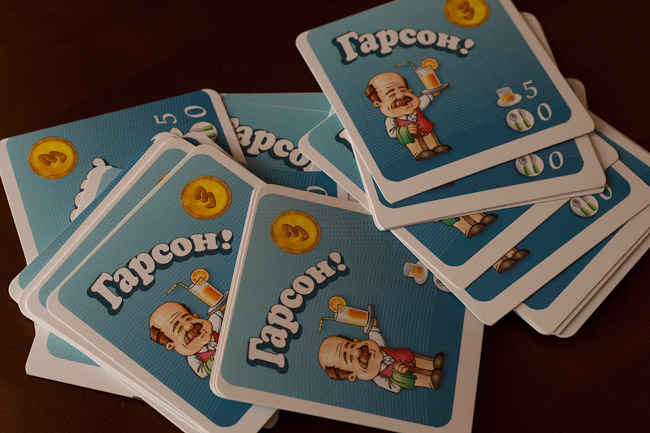
Perfect example of knife shear
Even at the very beginning of the circulation, the very same debug sheets can be caught: recount, it is possible that you have shipped more copies, and you just need to throw out the first part. It is easiest to recalculate by weighing on an accurate scale or with a ruler, knowing the thickness of the reference stack of paper of a given thickness.
Look at the packaging of big things: posters stuck with scotch, most often - not good.
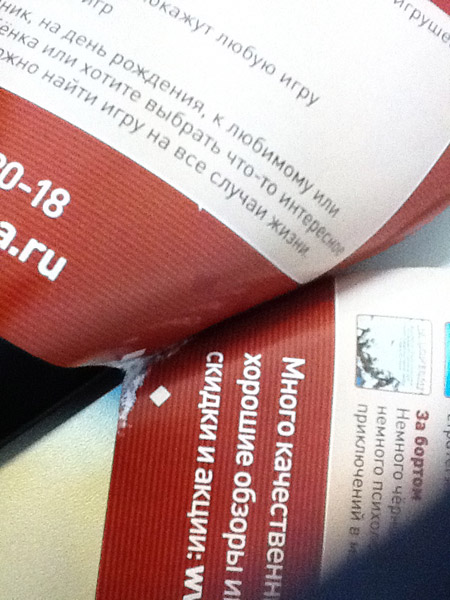
Transportation in winter + warm storage = condensate
If you have something a piece - you need to collect circulation. For example, when we collected the Startup , all the cards came in about these boxes.

Visiting cards
The manager who took the order spent about an hour to collect one full deck - and found out that there were not enough cards. We rummaged through the entire warehouse, found out the driver who delivered all this - and as a result, the box with the map was found in the printing house’s warehouse under something else heavy.
There are also hidden shoals. We once recalled the game from the stores, because it differed in the “self-destructing” box. The bottom, set on the glue, just departed exactly two weeks later, as if on a timer. The box hangs itself and hangs, time passes and - once! - contents on the floor. Then it turned out, glued in a 30-degree frost.
Vice versa
On the other hand, we often do it ourselves: sometimes we miss typing errors in the headlines (which are so huge that no one thinks to check them), sometimes the game goes to print with the wrong details, before a couple of times they incorrectly collected sheets of cards for different games, once sent a low-res preview instead of a layout, and so on. As I already mentioned - it is optimal to print one thing yourself and sign on it.
Selection of stocks:
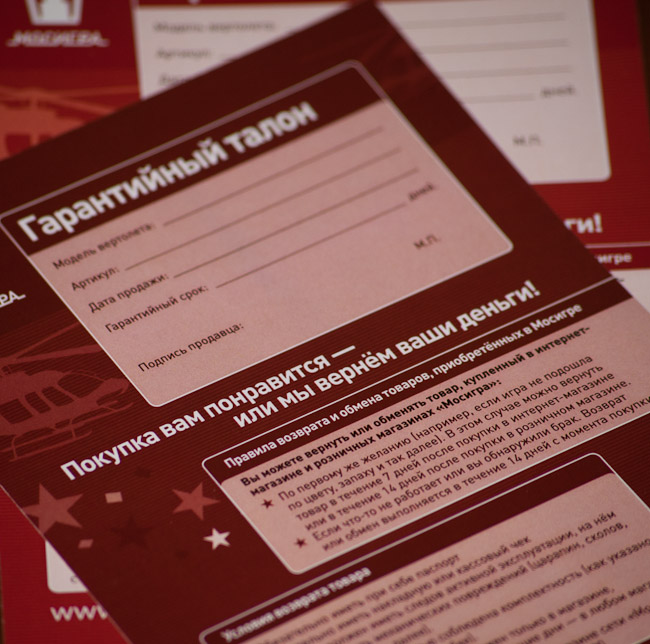
The color of different circuits is different - the most common problem. It happens when there are many different machines in the printing house, different paper is selected, or the wrong settings are simply rolled, or the paint changes. Sometimes it comes to the fact that the color of the circulation does not coincide with the color of the color proof.

This is not a defocus photo, this is a defocus printhead of the printer. Head is not well tuned - image is blurry.
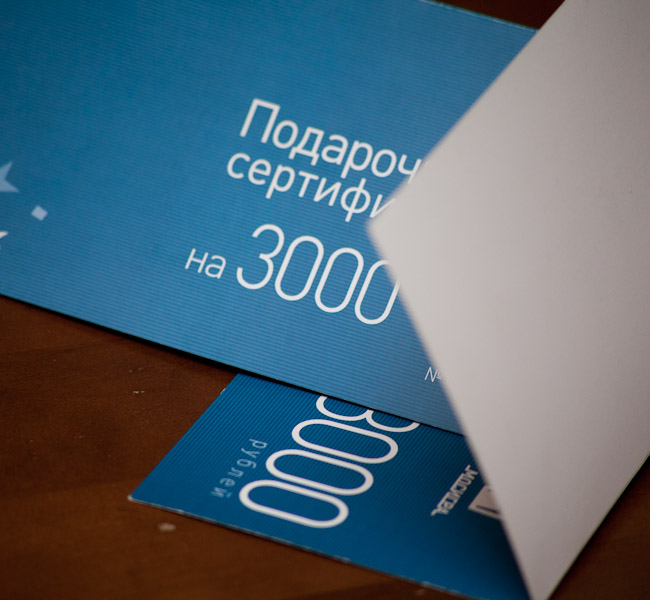
Good to send a prototype or sample. This piece was sent without a prototype, the printing house decided to print several hundred without the approval of the trial. In order to avoid, we print materials on the printer in the office and fold them as needed.

Surprise! Even with an obvious layout, you can get such an assembly.

Normal stripes when printing. This bug is remarkable because it appeared exactly in the middle of the circulation, that is, the upper part of the stack was normal.

Printing posters on gloss. The poster immediately turned into a tube, he stuck with the next, and then tore off. Printing on matte paper or proper drying solves the problem.
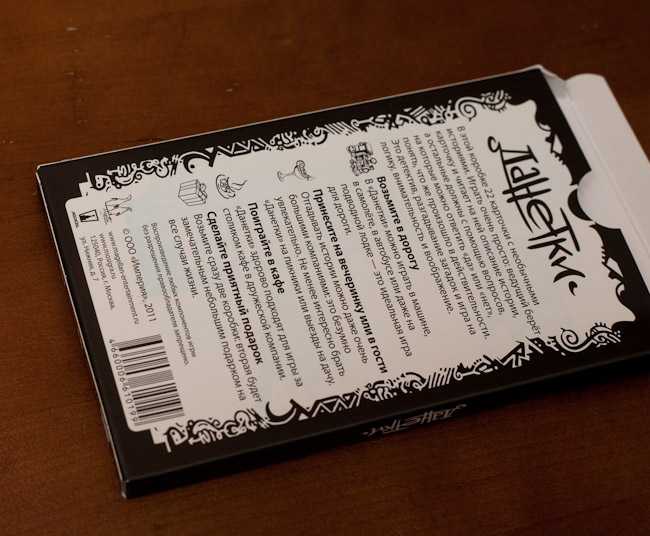
In the lower part of the box there are clearly visible traces of alien activity.
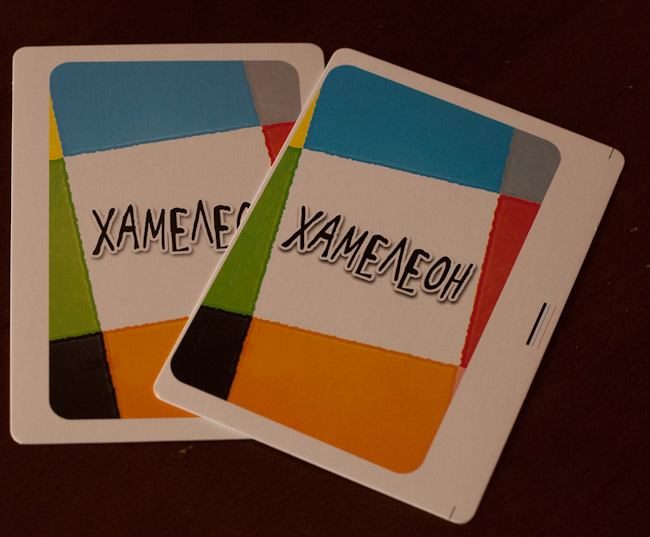
The card is cut down on the most tags
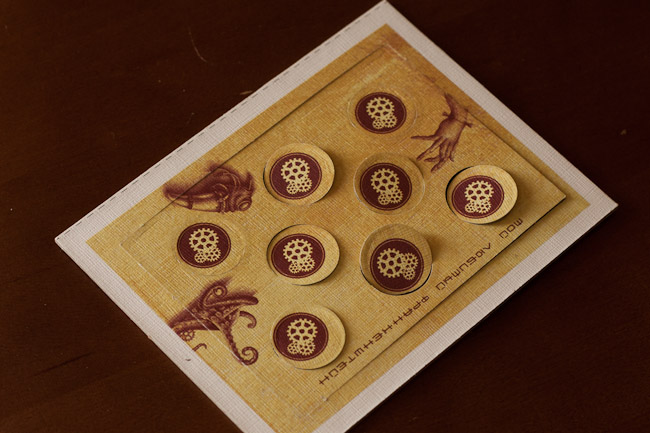
Almost hit the GOST
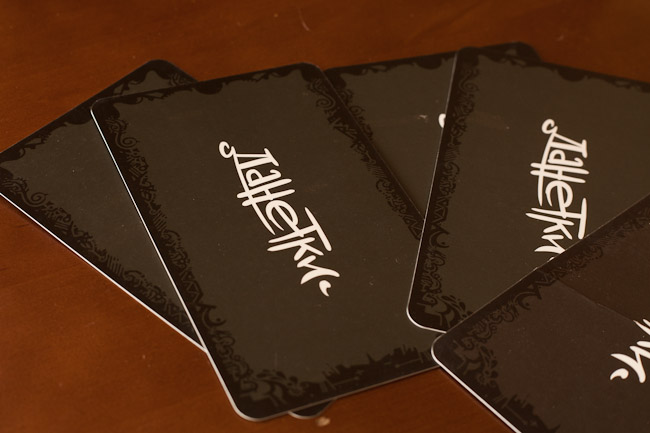
Krap from dust in the printing mechanism (the first cards) and the hall (last)
The sooner there is a problem, the better. Our developers joke that the worst case is a call to the office, starting with the words: “Hello! I am now standing in a shop in Kiev, and I have in my hands a box of the last edition ... "
Traditionally, I ask you to add and tell if you have attacked agricultural implements that we have not yet found.
Source: https://habr.com/ru/post/148342/
All Articles